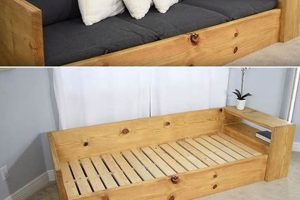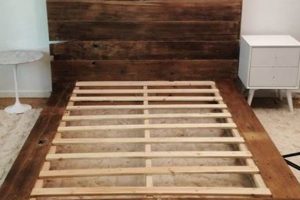A self-constructed support structure, often employing an “A” shaped design, intended for suspending a swinging apparatus. Such structures typically utilize wood or metal as the primary building material. For example, a homeowner may choose to build a sturdy, wooden framework in their backyard to support a child’s swing set.
Creating a customized support offers opportunities for cost savings compared to purchasing pre-fabricated sets. Furthermore, individuals can tailor the dimensions and materials to perfectly suit their available space and desired aesthetic. Historically, these projects have provided a means for families to personalize outdoor play areas and create lasting memories.
The subsequent sections will delve into essential aspects of designing and constructing these supports, including material selection, safety considerations, and step-by-step building instructions. These guidelines aim to empower individuals with the knowledge needed to undertake such a project safely and effectively.
Essential Guidelines for Support Structure Construction
The following guidelines offer crucial advice for erecting a safe and durable support structure for swinging activities. Adherence to these recommendations will contribute to the longevity and stability of the finished product.
Tip 1: Material Selection: Employ pressure-treated lumber or corrosion-resistant metal to withstand outdoor elements. Untreated materials are prone to rot or rust, compromising structural integrity over time. Consider the weight capacity of the chosen material to ensure it can adequately support the intended load.
Tip 2: Foundation Stability: Anchor the base of the support structure firmly in the ground. Concrete footings or buried posts provide essential stability, preventing tipping or shifting during use. The depth and diameter of the footings should be calculated based on soil conditions and the size of the structure.
Tip 3: Accurate Angle Measurement: Precisely measure and cut the angled supports to ensure a stable “A” shape. Inaccurate angles weaken the overall structure and increase the risk of collapse. Utilize a protractor or angle finder for optimal precision.
Tip 4: Secure Fastening: Use galvanized or stainless steel hardware to assemble the frame. Screws or bolts provide greater strength and resistance to loosening compared to nails. Pre-drilling pilot holes prevents wood splitting during assembly.
Tip 5: Weight Distribution Assessment: Test the completed structure with a load exceeding the anticipated maximum weight. This stress test identifies potential weaknesses before actual use. Observe for any signs of bending, creaking, or instability.
Tip 6: Regular Maintenance Protocol: Conduct routine inspections for signs of wear, damage, or corrosion. Tighten loose hardware and promptly replace any compromised components. Proper maintenance extends the lifespan of the structure and ensures continued safety.
Tip 7: Compliance with Safety Standards: Research and adhere to relevant safety standards and building codes. These regulations provide guidelines for structural integrity and user safety. Consult with local authorities for specific requirements in the area.
Following these guidelines enhances the safety and durability of the support structure, providing a secure and enjoyable swinging experience.
The subsequent section provides detailed instructions on the practical steps involved in building a functional and reliable support structure.
1. Material Strength
Material strength constitutes a foundational consideration in the construction of a swing support. The selected material must withstand the static and dynamic forces imposed by swinging activities to ensure structural integrity and user safety.
- Tensile Strength and Load Capacity
Tensile strength represents a material’s resistance to being pulled apart by tension. In the context of a swing support, this directly correlates to the maximum weight the frame can bear without fracturing or deforming. For example, using steel with a high tensile strength allows for a greater load capacity compared to using a softwood with a lower tensile strength. The failure to adequately assess tensile strength may result in catastrophic structural failure under load.
- Compressive Strength and Support Stability
Compressive strength refers to a material’s ability to withstand forces that compress or squeeze it. In a swing support, the vertical posts experience compressive forces from the weight of the swing and its occupants. Choosing a material with insufficient compressive strength can lead to buckling or crushing of the posts, compromising the overall stability of the structure. Concrete footings, often used to support the posts, must also possess adequate compressive strength.
- Shear Strength and Joint Integrity
Shear strength denotes a material’s resistance to forces that cause internal slippage or sliding along a plane. The joints of a swing support, where horizontal and vertical members connect, are subjected to shear forces. Weak joints can fail under shear stress, leading to instability and potential collapse. Proper joint design, utilizing fasteners with adequate shear strength, is crucial for maintaining structural integrity.
- Durability and Environmental Resistance
Durability encompasses a material’s ability to withstand degradation from environmental factors, such as moisture, sunlight, and temperature fluctuations. Outdoor structures are particularly vulnerable to these factors. Using materials that are not weather-resistant, such as untreated wood, can lead to rot, corrosion, and a significant reduction in strength over time. Pressure-treated lumber or powder-coated steel are examples of materials offering enhanced durability and environmental resistance.
The selection of materials with appropriate strength characteristics is paramount to the safe and reliable construction of a swing support. A thorough understanding of tensile, compressive, shear, and environmental resistance properties ensures the structural integrity and longevity of the apparatus, mitigating the risk of failure and promoting user safety.
2. Structural Integrity
Structural integrity is of paramount importance in the context of constructing a swing support. The capacity of the structure to withstand applied loads without failure directly influences the safety and longevity of the apparatus. Careful consideration of design and construction techniques is crucial to ensuring structural soundness.
- Joint Design and Execution
Joints represent the points of connection between structural members and are often the weakest links in a system. Proper joint design involves selecting appropriate connection methods, such as mortise-and-tenon, bolted connections, or welded joints. The execution of these joints requires precision and attention to detail to ensure a secure and load-bearing connection. For example, a poorly executed bolted connection can result in slippage or shear failure under load, compromising the entire structure. Ensuring each joint is meticulously constructed significantly enhances overall stability.
- Material Selection and Load Capacity
The selection of materials must align with the anticipated load requirements. Different materials possess varying degrees of tensile strength, compressive strength, and shear strength. Pressure-treated lumber, for instance, is frequently used due to its resistance to decay, but its load-bearing capacity must be considered relative to the weight it will support. Similarly, steel offers superior strength but requires protection against corrosion. The improper selection of materials, without consideration for their load capacity, can lead to structural failure. A structure designed to carry a substantial load must utilize materials capable of meeting or exceeding those demands.
- Triangulation and Bracing Techniques
Triangulation, the use of triangular shapes in structural design, enhances stability by distributing forces across multiple members. Bracing, such as cross-bracing or diagonal bracing, further reinforces the structure against lateral loads, preventing racking or deformation. The absence of triangulation or bracing can render the structure susceptible to collapse under wind load or dynamic forces. Incorporating these techniques into the design increases the stiffness and resistance to deformation of the swing support.
- Foundation Stability and Anchoring
The foundation provides the base of support and must be stable enough to prevent tipping or settling. Concrete footings, buried posts, or ground anchors can provide the necessary stability, depending on soil conditions and the size of the structure. Inadequate anchoring can lead to instability, particularly during high winds or when subjected to swinging forces. The depth and diameter of the footings should be calculated based on soil conditions and the anticipated loads. A firm foundation is crucial for maintaining the structural integrity of the entire assembly.
Integrating robust joint design, appropriate material selection, triangulation and bracing, and a stable foundation is essential for ensuring the structural integrity. When constructing any support, diligence in each of these areas promotes both user safety and the structure’s enduring performance.
3. Anchoring Method
The anchoring method constitutes a critical determinant in the stability and safety of any self-constructed support for swinging activities. Proper anchorage prevents tipping, shifting, and potential collapse, ensuring the structure remains secure under dynamic loads and environmental conditions.
- Direct Burial of Posts
Direct burial involves setting the support posts directly into the ground, typically encased in concrete. This method offers a relatively simple approach but necessitates the use of pressure-treated lumber to resist rot and decay. The depth of the burial must be sufficient to withstand overturning forces, and proper drainage around the posts is essential to prevent moisture accumulation. Inadequate burial depth or insufficient drainage can compromise the structural integrity of the support, leading to instability or premature failure.
- Concrete Footings
Concrete footings provide a more robust anchoring solution by distributing the load over a wider area. This method involves excavating holes, pouring concrete footings below the frost line, and then attaching the support posts to the footings using appropriate hardware. Concrete footings offer superior stability and resistance to frost heave, a significant consideration in regions with cold climates. Proper footing dimensions and secure post-to-footing connections are essential for ensuring long-term stability.
- Surface Mounting with Anchors
Surface mounting involves attaching the support posts to a pre-existing concrete slab or patio using anchors. This method requires the use of heavy-duty anchors specifically designed for concrete applications. Surface mounting is generally less stable than direct burial or concrete footings and is best suited for smaller, lighter-duty swinging structures. The anchor type and spacing must be carefully selected to provide adequate holding power, and the condition of the concrete slab must be assessed to ensure it can withstand the applied loads.
- Ground Anchors and Augers
Ground anchors and augers offer a non-permanent anchoring solution that can be useful for temporary or portable swinging structures. These devices are screwed or driven into the ground to provide resistance against uplift and lateral forces. The effectiveness of ground anchors depends on soil conditions, and they may not be suitable for areas with loose or sandy soil. Proper installation and regular inspection are essential to ensure the anchors remain secure.
Selecting an appropriate anchoring method requires careful consideration of soil conditions, climate, structure size, and anticipated load. The chosen method must provide adequate stability and resistance to both static and dynamic forces to ensure the safety and longevity of the self-constructed support for swinging activities. Improper or inadequate anchorage presents a significant safety hazard and should be avoided.
4. Joint Security
In the construction of a self-assembled support intended for swinging apparatus, joint security represents a critical factor influencing structural integrity and user safety. The points where individual structural members connect bear significant stress, making them potential points of failure. Secure joints directly impact the load-bearing capacity and stability of the entire structure. For instance, if the joints connecting the “A” frame legs to the horizontal support beam are inadequately secured, the entire structure may collapse under the combined weight of the swing and its user. Therefore, meticulous attention to joint security is non-negotiable.
Various methods exist for achieving secure joints in such structures. Bolted connections, utilizing galvanized or stainless steel hardware, offer superior strength compared to nailed connections. Wood screws, while suitable for lighter loads, may loosen over time, necessitating periodic inspection and tightening. Mortise and tenon joints, particularly when reinforced with adhesive and fasteners, provide robust connections for wooden structures. Welding, applicable for metal frames, creates exceptionally strong and permanent joints, but requires specialized skills and equipment. Regardless of the chosen method, the integrity of each joint directly affects the overall safety profile. A real-world example includes the selection of through-bolted connections over simple wood screws for a backyard swing set intended for multiple children. This choice demonstrably increases the structure’s capacity to withstand dynamic forces.
Ultimately, joint security is an indispensable component of a structurally sound, self-assembled swing support. Improperly secured joints present an unacceptable safety risk. The selection of appropriate connection methods, coupled with diligent execution and routine inspection, is essential. Ignoring this aspect compromises the entire structure, potentially leading to injury. Therefore, prioritized consideration of joint integrity represents a cornerstone of responsible construction.
5. Weight Capacity
Weight capacity constitutes a critical design parameter when undertaking a self-constructed support for swinging apparatus. This parameter dictates the maximum load the structure can safely bear, encompassing the weight of the swing itself, any attached accessories, and the intended users. Failure to accurately assess and accommodate weight capacity can result in structural failure, leading to potential injury or property damage. For example, if a frame is designed to support a single child but is subsequently used by multiple individuals, the excessive load can cause joints to fail or the frame to collapse.
Calculating the required weight capacity involves considering the maximum anticipated load scenario. This necessitates factoring in not only the average weight of users but also potential dynamic loads generated by swinging motions. Dynamic loads can significantly exceed static weight, especially during vigorous swinging. Furthermore, material properties, such as the tensile strength of wood or the yield strength of steel, must be carefully considered to ensure the chosen materials can withstand the anticipated stresses. A practical application of this understanding lies in the selection of appropriately sized lumber for the frame’s primary support beams; a larger beam cross-section provides increased load-bearing capacity.
In conclusion, weight capacity is an indispensable design consideration for a self-constructed support intended for swings. Accurately assessing and accommodating the intended load, accounting for both static and dynamic forces, is paramount to ensuring structural integrity and user safety. Challenges often arise from underestimating dynamic loads or failing to properly account for material properties. However, adhering to sound engineering principles and conservative load estimations mitigates these risks and ensures a safe and enjoyable swinging experience.
6. Spatial Dimensions
Spatial dimensions represent a crucial consideration in the design and construction of a self-made swing support. These dimensions encompass the overall size and shape of the structure, the clearances required for safe swinging, and the integration of the support within the available space. Appropriate attention to spatial dimensions ensures functionality, safety, and aesthetic harmony.
- Footprint and Area Requirements
The footprint of the support dictates the area it occupies on the ground. This area must be carefully considered in relation to the available space in the yard or designated play area. A structure that is too large may encroach on other landscape features or create a confined feeling. Conversely, a footprint that is too small may compromise stability or restrict the range of motion of the swing. Examples include accurately measuring the intended location to ensure the structure fits without obstructing walkways or vegetation. The implications of an improperly sized footprint extend to potential safety hazards and aesthetic disharmony.
- Height and Swing Clearance
The height of the support determines the maximum height of the swing and the necessary clearance above the ground. Sufficient clearance is essential to prevent users from striking the ground during swinging. Additionally, adequate overhead clearance is required to prevent collisions with overhead structures, such as tree branches or power lines. Failure to account for swing clearance can result in serious injury. A real-world example involves adjusting the height of the crossbeam based on the length of the swing chains and the anticipated height of the users. This ensures a safe swinging experience with ample vertical clearance.
- Swing Spacing and Lateral Clearance
When multiple swings are installed on a single support, adequate spacing between the swings is necessary to prevent collisions between users. Lateral clearance, the distance between the swings and any surrounding objects, must also be considered to ensure a safe swinging environment. Insufficient swing spacing can lead to injuries from accidental contact, while inadequate lateral clearance can result in collisions with trees, fences, or other obstacles. The implications of improper spacing are heightened in environments with multiple users. Careful planning of swing placement, accounting for the maximum swing arc, mitigates the risk of collisions and enhances user safety.
- Integration with Surroundings
The dimensions and style of the support should complement the surrounding landscape and architectural features. A structure that is out of scale or clashes with the existing aesthetic can detract from the overall appeal of the space. Consider factors such as material selection, color scheme, and overall design to create a harmonious integration with the environment. For instance, a rustic wooden frame may blend well with a natural landscape, while a sleek metal frame may be more appropriate for a modern backyard. The integration of the structure within its surroundings contributes to both functionality and visual appeal, enhancing the overall user experience.
These facets highlight the interplay between spatial dimensions and successful construction. The careful assessment and incorporation of these considerations result in a safe, functional, and aesthetically pleasing addition to any outdoor space. Overlooking spatial dimension leads to restricted movement, accidents, and a less pleasing surrounding.
7. Safety Standards
The construction of a self-assembled swing support necessitates strict adherence to established safety standards. These standards, often defined by regulatory bodies and industry best practices, serve to minimize the risk of injury associated with swinging activities. Non-compliance with these standards can directly lead to structural failures, resulting in falls or collisions. For example, failure to adhere to recommended lumber sizing guidelines can cause a frame to buckle under load, posing a significant hazard. Safety standards provide a framework for ensuring adequate structural integrity, appropriate clearances, and the use of durable materials, all vital components of a safe swinging environment.
Several specific safety standards directly impact the construction process. These include guidelines on the selection of appropriate wood or metal types, specifications for joint construction and fastening techniques, and recommendations for ground anchoring methods. Furthermore, standards dictate minimum clearances around the swing set to prevent collisions with surrounding objects, such as trees or fences. Proper execution of these standards requires a comprehensive understanding of engineering principles and practical construction skills. For instance, ensuring that all hardware, such as bolts and screws, meets specified strength requirements directly correlates to the longevity and safety of the structure. Regular inspection and maintenance, as dictated by safety guidelines, further mitigate risks over time.
In summation, integrating safety standards into every stage of a swing support construction is non-negotiable. The consequences of neglecting these standards range from minor equipment malfunctions to severe personal injuries. By actively referencing and complying with relevant safety guidelines, constructors can significantly enhance the safety and usability of their creations, ensuring a secure and enjoyable swinging experience. The practical significance of this understanding lies in creating safe environments for children and adults alike, reinforcing the role of responsible construction practices.
Frequently Asked Questions
The following addresses common inquiries regarding the construction of swing frameworks, offering guidance on safety, materials, and construction techniques.
Question 1: What constitutes the most critical factor in ensuring the safety of a swing apparatus?
Structural integrity. All components, including posts, crossbeams, and joints, must withstand anticipated loads. Regular inspection for wear and tear is also imperative.
Question 2: Which material is deemed superior for constructing an outdoor swing support, wood or metal?
Both offer viable options. Pressure-treated lumber resists rot and insect infestation, while steel provides greater strength and durability. The selection should align with project budget, aesthetic preferences, and load requirements.
Question 3: What is the recommended depth for burying support posts in the ground?
A minimum depth of two feet is generally advised, contingent upon soil conditions and frost line depth. Local building codes should be consulted for definitive requirements.
Question 4: Is concrete footing necessary for stabilizing a swing support structure?
Highly recommended. Concrete footings distribute the weight of the structure and prevent sinking or shifting, particularly in unstable soil conditions.
Question 5: What type of hardware is appropriate for assembling a swing structure?
Galvanized or stainless steel hardware is recommended to resist corrosion and maintain structural integrity over time. The hardware should possess sufficient strength to withstand anticipated loads.
Question 6: How often should a swing structure be inspected for safety?
Routine inspections should be conducted at least twice annually, or more frequently if the structure is subject to heavy use. Particular attention should be paid to joints, hardware, and signs of wood rot or metal corrosion.
These guidelines serve as a baseline for safe construction. Professional consultation is advised for complex projects or when uncertainty exists.
Subsequent sections will provide detailed step-by-step instructions for building different types of swing supports.
DIY A Frame for Swing
The preceding discussion underscores the importance of meticulous planning and execution in the construction of a self-supported swinging apparatus. From material selection and structural integrity to anchoring methods, joint security, weight capacity considerations, spatial dimensioning, and adherence to safety standards, each element contributes to the overall safety and functionality of the structure. The application of sound engineering principles and a thorough understanding of relevant building codes are paramount.
Ultimately, a commitment to responsible construction practices will ensure a durable and safe environment for swinging activities. Regular inspection and maintenance are essential to prolong the lifespan of the structure and address any potential hazards. By prioritizing safety and investing in quality materials and workmanship, individuals can create a lasting and enjoyable addition to their outdoor space, mindful of their responsibility to user safety.







